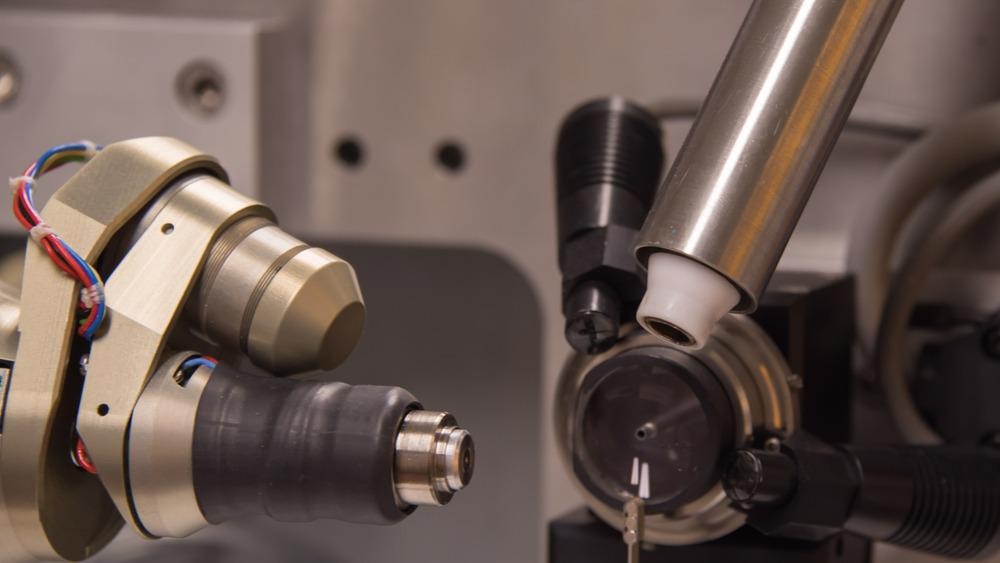X-ray diffraction (XRD) is a technique for analyzing the atomic or molecular structure of materials. Crystalline materials are the most analyzed type of material XRD but there are variations of the methodology that are suitable for other types of material such as powder X-ray diffraction.

Image Credit: Gianmix/Shutterstock.com
How Does XRD Work?
XRD works by shining incident X-ray light onto a sample and measuring the intensity and the angle of the diffracted X-ray radiation. The incident radiation penetrates the periodic lattice of the material and, if the incident wavelength is correctly tuned, some of this radiation will be diffracted at an angle known as the Bragg angle, which is equal to half the angle of the incident radiation.
In XRD experiments, the incident X-ray beam must be monochromatic. This is because, for diffraction to occur, the path length difference due to the lattice spacing in the sample for the outgoing wave, must be equal to an integer number of wavelengths. The broader the incident wave is in energy the poorer the resolution of the diffraction pattern, which may limit the atomic spacings that can be resolved.1
If a system has a regular periodic structure, then the scattering from subsequent planes in the crystals will interfere constructively and contribute to the diffraction pattern observed. It is necessary to use X-ray radiation to record diffraction patterns of materials as interatomic distances in materials typically fall in the range of ~ 2-3 Å and the wavelength must be matched to the lattice spacings.
XRD Signals
When finding a diffraction pattern for a new material where the Bragg angle is not necessarily known, there are two different approaches. There is what is known as the Laue method that scans the central wavelength of the monochromatic incident beam, or the crystal sample can be rotated in place within the X-ray diffractometer to find and record the full X-ray diffraction pattern. The crystal structure can then be resolved by reconstruction of the observed diffraction pattern.2
The peak positions in an XRD spectrum provide information on the spacing of the unit cell as well as its symmetry, which is crucial information for crystal identification. Relative intensity information can be used to work out atomic species and the coordinates of atoms in the unit cell, whereas absolute peak intensities provide phase information – how abundant a given phase of the crystal is in the system. Peak widths can also be used to make inferences about the amount of stress and strain within the crystal system.
XRD in Materials Research
The biggest application of XRD is in materials research.3 There are now several databases with information on both crystalline and powder X-ray diffraction spectra that can be combined with automated peak search and matching methods for compound identification.
Comparison of the information on the angle of scattering and relative intensities patterns from the measured sample to databases can provide a confidence level of identification of a given elemental composition and phase of the substrate.
A high-resolution XRD experiment is sufficiently sensitive that it can be used in more complex situations, such as when dealing with polytypes. Polytypes have the same elemental composition and often have very similar structures that differ only by small changes in the dimensions of the unit cell. As XRD is sensitive to small changes in the unit cell spacings, it can be used to distinguish these similar phases.
XRD may be combined with other techniques, such as X-ray fluorescence, that are better suited for elemental identification of the species in the material. This can be useful for scenarios where the crystal structures are similar but differ in their elemental composition as XRD is only sensitive to spacings.
As well as crystalline and powder samples, for materials research, XRD can be used to measure the structure of thin films. For thin film measurements, often a θ/2θ scan is used where the sample is rotated out of the crystal plane and again rotated in the crystal plane using the X-ray diffractometer. For thin films deposited on substrates, XRD can be invaluable for learning about the stress and strain interactions due to the bonding as well as about the thickness of the film.
XRD has become so widely used it is one of the standard characterization techniques in materials research. While some experiments require the use of the energy tunability and intensity of advanced light sources such as synchrotrons, many research institutions have their own X-ray diffractometers. Some will have several diffractometers with different X-ray sources to cover the different energy ranges needed for the investigation of different materials.
References and Further Reading
- Bunaciu, A. A., Udriştioiu, E., Aboul-enein, H. Y., Bunaciu, A. A., Udriştioiu, E., Aboul-enein, H. Y., Bunaciu, A. A., & S, E. G. U. (2015). X-Ray Diffraction : Instrumentation and Applications X-Ray Diffraction : Instrumentation and Applications. Critical Reviews in Analytical Chemistry, 45, 289–299. https://doi.org/10.1080/10408347.2014.949616
- Chatterjee, S. K. (2010). X-ray diffraction: Its theory and applications. PHI Learning Pvt. Ltd.
- Lee, M. (2017). X-Ray diffraction for materials research: from fundamentals to applications. CRC Press.
Disclaimer: The views expressed here are those of the author expressed in their private capacity and do not necessarily represent the views of AZoM.com Limited T/A AZoNetwork the owner and operator of this website. This disclaimer forms part of the Terms and conditions of use of this website.